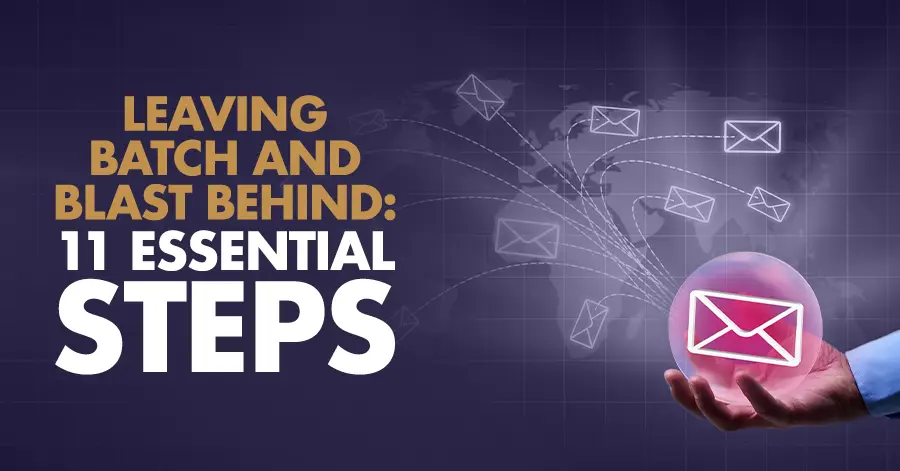
Batch and blast email campaigns certainly require far less time to put together than more personalized messages. But as most marketing experts understand, the tradeoff isn’t worth it. Batch and blast messages are known to produce significantly less revenue than personalized emails sent to interested contacts.
However, simply knowing that personalized messages perform better is just the first step. The real challenge comes when making the transition from the low-performing but easy batch and blast strategy to more demanding personalized campaigns. Here’s what eleven industry experts have to say.
Allocate More Time & Resources

Patrick Beltran,
Marketing Director, Ardoz Digital
From my experience, one of the main hurdles with transitioning to personalized email marketing, as opposed to the more generic batch-and-blast campaigns, is that it requires considerably more time and effort. This is especially challenging for small businesses that often struggle with limited time and resources to maintain consistency in their marketing efforts. Thankfully, there are now tools available to help streamline this process.
For instance, we use automated campaign tools and platforms like Townsquare Interactive’s business management platform, which allows us to handle our email marketing efforts from top-of-funnel to bottom. This platform integrates an inbox, calendar features, customer relationship management tools, and automated email and SMS messaging, providing everything necessary to grow our subscriber base effectively.
Additionally, we focus on prioritizing high-impact activities. We concentrate on email marketing strategies that align closely with our business goals and offer the most significant return on investment. We ensure that every email includes strong calls to action, tied to conversion activities like booking a demo or purchasing a product or service. This has helped us make the most of our efforts in email marketing by directly influencing our business outcomes.
Navigate Privacy & Compliance Issues

Marc Bishop, Director, Wytlabs
A significant challenge in personalized email marketing is navigating the increased privacy concerns and ensuring compliance with regulations such as GDPR. Customers are more sensitive about how their data is being used, and rightly so. To tackle this, we have made transparency a core part of our email strategies, ensuring that our communications clearly state how we use data and providing customers with easy options to control their privacy preferences. This helps build trust and ensures that we comply with legal standards, thereby protecting our business and our customers’ rights.
Ensure Data Cleanliness & Reliability

Jonathan Buffard,
Digital Marketing Director, Bottom Line Marketing Agency
If you want to get more from your email marketing, personalization is the name of the game. But it’s not without its challenges. One of the biggest hurdles is ensuring your data is clean, uniform, and reliable. The amount of personalization you implement depends on how many data points you have for your contacts.
Your audience data properties need to be consistently formatted and correctly inputted. Behavioral segmentation must be spot-on; targeting folks based on actions like adding to a shopping cart or clicking on a product requires precise and accurate segment creation.
Keeping your data updated is crucial. Customer behaviors and preferences evolve, and your segmentation must dynamically reflect these changes. Implementing real-time data-tracking and updating systems can help maintain the relevance and accuracy of your personalized campaigns.
In short, transitioning to personalized email campaigns means paying close attention to data integrity and segmentation accuracy. Nail these aspects, and you’ll unlock the true power of personalization, driving better engagement and results from your email marketing efforts.
Manage Increased Data Complexity

Josh Bluman, Co-Founder, Hoppy Copy
That would be managing the increased complexity in data and segmentation. Personalized campaigns require more detailed customer data and sophisticated segmentation strategies to ensure that each email is relevant to the individual recipient.
For instance, you’ll need to invest in tools and processes for gathering and analyzing customer data to create tailored content. This might mean integrating CRM systems, enhancing your email marketing platform’s capabilities, and developing more granular customer profiles. Initially, it can be a bit overwhelming, but the payoff is worth it: personalized campaigns tend to see higher engagement and conversion rates than generic batch-and-blast emails. Investing in the right technology and processes will help you effectively manage this complexity and deliver more impactful, personalized content.
Produce Creative & Relevant Content

Austin Benton, Marketing Consultant, Gotham
Motivational Speakers
One challenge marketers might face is the need for creative and compelling content that resonates with diverse audiences. Unlike batch-and-blast campaigns, which rely on a one-size-fits-all message, personalized campaigns require tailored content that aligns with individual customer interests and stages in the buyer’s journey. This necessitates a deeper understanding of customer personas and their motivations, which can be resource-intensive. Marketers may struggle to consistently produce high-quality, relevant content for every segment, making it crucial to establish a strong content strategy that emphasizes creativity and adaptability.
Balance Personalization & Scalability

Yoyao Hsueh, Founder, TopicalMap.com
One significant challenge when shifting from batch-and-blast to personalized email campaigns is effectively segmenting your audience and creating relevant content for each segment. Start small, measure results, and continuously refine your approach based on performance data. The transition requires a deep understanding of your customer base, often involving collecting and analyzing vast amounts of data. This can be overwhelming, especially for smaller teams or those with limited data analytics capabilities.
Creating multiple versions of content tailored to different segments is time-consuming and resource-intensive. It requires a delicate balance between personalization and scalability to ensure the effort remains manageable and cost-effective. We tackled this by starting with broad segmentation based on user behavior and gradually refining our approach. We developed content blocks that could be mixed and matched for different segments, which helped streamline the process.
Integrate & Manage Vast Data

Reed Daniels, Owner, Rail Trip Strategies
When shifting from batch-and-blast to personalized email campaigns, one significant challenge marketers can expect is managing and integrating the vast amounts of data required to create truly personalized experiences. Personalization demands a deep understanding of individual customer preferences, behaviors, and interactions, which involves collecting, analyzing, and acting on data from various sources.
We faced this challenge head-on when we moved from generic email campaigns to more personalized approaches. Here’s how we addressed and overcame this challenge:
Firstly, we recognized the need for a robust data management system. Our existing infrastructure was not equipped to handle the detailed segmentation and dynamic content needs of personalized campaigns. We invested in a comprehensive CRM system integrated with our email marketing platform. This allowed us to centralize customer data, track interactions, and segment our audience based on specific criteria such as past behaviors, interests, and demographic information.
The next step involved ensuring data accuracy and completeness. Inaccurate or incomplete data can lead to ineffective personalization and even damage customer trust. We undertook a thorough data-cleaning process, removing duplicates, filling in missing information, and regularly updating our database to ensure it reflected the most current and relevant customer details. Creating personalized content at scale was another significant challenge. Unlike batch-and-blast campaigns, which rely on a single message sent to everyone, personalized campaigns require multiple versions of emails tailored to different segments.
To manage this, we developed a content strategy that included dynamic content blocks within our emails. These blocks automatically adapted based on the recipient’s profile and behavior, allowing us to deliver relevant messages without manually creating countless variations. Another crucial aspect was ensuring seamless integration across all touchpoints.
Personalization is not limited to email but extends to all customer interactions, including website visits, social media engagements, and customer service interactions. We used marketing automation tools to track these interactions and trigger personalized emails based on real-time behaviors, such as abandoned carts or recent purchases.
Ensure Content Relevance & Timing
A challenge is ensuring that the personalized content is not only relevant but also timely. The effectiveness of a personalized email campaign can diminish if the content reaches the recipient at the wrong time. To address this, we utilize predictive analytics to understand optimal timing for engagement based on past interactions. This data-driven approach ensures that our emails are not only relevant but also timely, increasing the likelihood of engagement and conversion.
Address High Initial Costs

James Owen, Co-Founder
& Director, Click Intelligence
The biggest challenge of switching to personalized email marketing is the initial costs. Batch-and-blast campaigns have a lower initial cost. This may make you doubt switching to personalized campaigns.
However, it is important to remember that email marketing will cost you less in the long run. Sending out mass emails is not as effective as a customized approach. Though your upfront costs will be lower, you will not convert as many customers.
Personalized email marketing has a higher initial cost because it requires specialized software. Your audience will engage more with your campaign, and you will save money. Customers will also have a more positive view of your brand when they do not see you as spam.
Deliver the Right Message

Casey Hart, Owner, Informer Messages on
hold
Batch-and-blast email has had its time… but today’s consumer opens up their email desktop every morning, and “delete, delete, delete.” If we have time, we also “unsubscribe.” The only effective marketing delivers the right message to the right people at the right time…when they’re already thinking of you. But there are more ways to do this than just PPC. Successful marketers will take the time to find and develop this kind of promotion because it just works better. These include: social media marketing, affiliate marketing, video marketing, referral marketing, and messages on hold.
Create a Single Customer View

Amir Elaguizy, CEO and Co-Founder, Cratejoy, Inc
In my experience, one of the toughest parts of prioritizing personalization over traditional batch-and-blast email campaigns is creating a single customer view. When you try to find common threads across different channels, the goal is to form a clearer image of who your customers truly are by integrating their data into one unified customer profile. However, research indicates that marketers often struggle to link data effectively to individual customer profiles. This challenge stems largely from the diverse data sources and types that need to be consolidated.
For example, a customer’s interaction on social media, their purchase history, and email engagement metrics must all be synchronized without discrepancies. Often, the technology or the systems in place aren’t fully equipped to handle this level of integration seamlessly. Moreover, ensuring data accuracy and consistency across channels can be a daunting task, as errors in data can lead to misguided personalization efforts that, rather than delight, might alienate customers.
If you’re still relying on batch and blast messages, it’s time to make the switch. Get in touch with our marketing experts today to develop a game plan.






